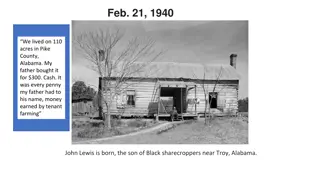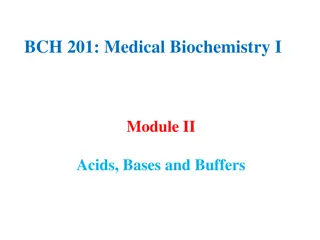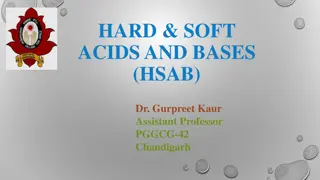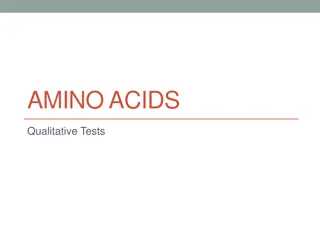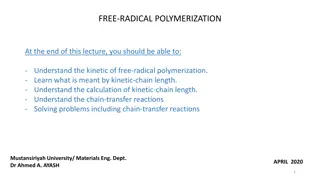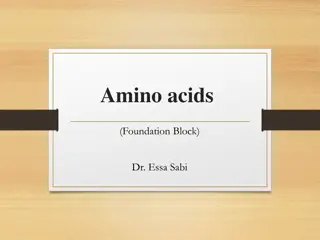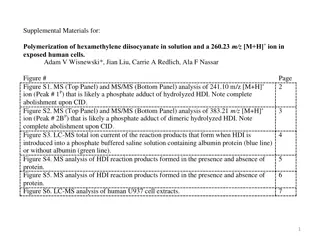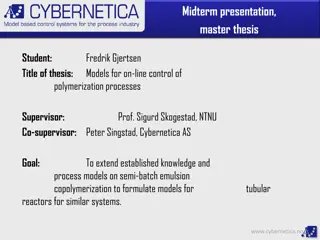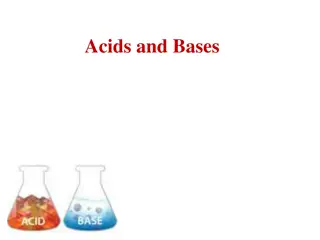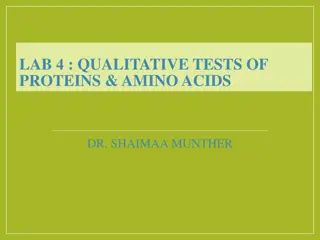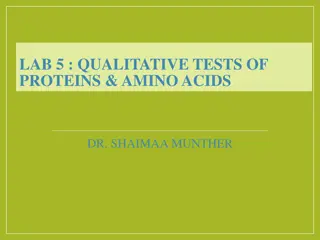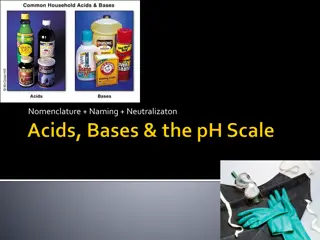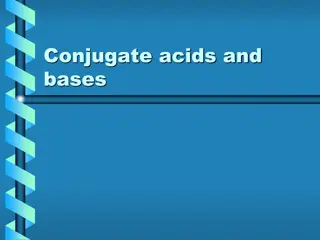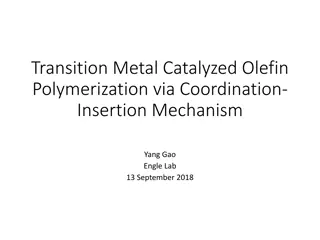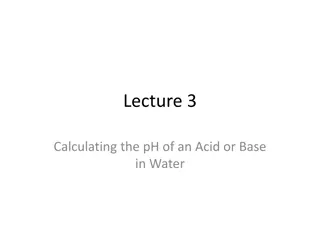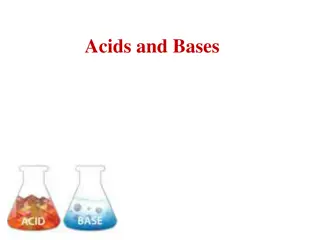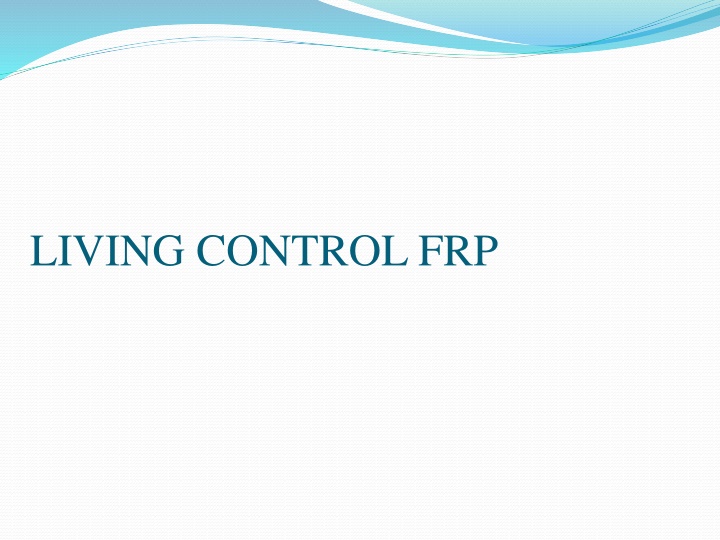
Initiating Polymerization with Protonic and Lewis Acids
Various initiators, including protonic acids and Lewis acids, play crucial roles in bringing about the polymerization of monomers with electron-releasing substituents. The choice of initiator impacts the overall polymerization rate and the molecular weights of the resulting polymers. Protonic acids, such as Brønsted acids, initiate cationic polymerization through protonation of olefins, while Lewis acids, like metal halides and their derivatives, initiate polymerization at low temperatures. Understanding the roles and limitations of these initiators is essential for controlling and optimizing polymer synthesis.
Download Presentation

Please find below an Image/Link to download the presentation.
The content on the website is provided AS IS for your information and personal use only. It may not be sold, licensed, or shared on other websites without obtaining consent from the author. If you encounter any issues during the download, it is possible that the publisher has removed the file from their server.
You are allowed to download the files provided on this website for personal or commercial use, subject to the condition that they are used lawfully. All files are the property of their respective owners.
The content on the website is provided AS IS for your information and personal use only. It may not be sold, licensed, or shared on other websites without obtaining consent from the author.
E N D
Presentation Transcript
Initiation Various initiators can be used to bring about the polymerization of monomers with electronreleasing substituents. ProtonicAcids : Protonic (Br nsted) acids initiate cationic polymerization by protonation of the olefin. The method depends on the use of an acid that is strong enough to produce a resonable concentration of the protonated species .
The method used in drawing the ionic species in these two equations show that the ionic species usually do not exist as free ions but as ion pairs. The parentheses around the anionic fragment is used to indicate that the negative counterion remains close to the positive fragment. (Even when the counterion is not shown, one should understand it is present.) However, keep in mind that free ions coexist with the ion pairs, and it is the relative concentrations that determine the overall polymerization rate.
The requirement for the anion not to be excessively nucleophilic generally limits the utility of most strong acids as cationic initiators. Hydrogen halides are ineffective as initiators of cationic polymerization because of the highly nucleophilic character of halide ions. One forms only the 1:1 addition product of alkene and hydrogen halide under most conditions.Hydrogen iodide shows some tendency to initiate polymerization of the most reactive monomers,such as vinyl ethers and N- vinylcarbazole . Other strong acids with less nucleophilic anions, such as perchloric, sulfuric, phosphoric, fluoro- and chlorosulfonic, methanesulfonic, and trifluoromethanesulfonic (triflic) acids, initiate polymerization, but the polymer molecular weights rarely exceed a few thousand.
Lewis Acids (A) Various Lewis acids are used to initiate cationic polymerization, generally at low temperatures,with the formation of high- molecular-weight polymers in high yield. These include metal halides (e.g., AlCl3, BF3, SnCl4, SbCl5, ZnCl2, TiCl4) and their organometallic derivatives (e.g., RAlCl2, R2AlCl, R3Cl). Lewis acids are the most important means of initiating cationic polymerization. Aluminium, boron, tin, and titanium halides are the most frequently used Lewis acids.
Initiation by Lewis acids almost always requires and/or proceeds much faster in the presence of either a proton donor (protogen) such as water, hydrogen halide, alcohol, and carboxylic acid, or a carbocation donor (cationogen) such as an alkyl halide (e.g., t-butyl chloride and triphenylmethyl chloride), ester, ether, or anhydride. Thus, dry isobutylene is unaffected by dry boron trifluoride but polymerization occurs immediately when trace amounts of water are added. the protogen or cationogen is referred to as the initiator, while the Lewis acid is the coinitiator.
The initiator and coinitiator, representing an initiating system, react to form an initiator coinitiator complex (or syncatalyst system), which then proceeds to donate a proton or carbocation to monomer and, thus, to initiate propagatio. The initiation process for boron trifluoride and water is
The initiatorcoinitiator complex BF3OH2 is often shown as H(BF3OH). Initiation by aluminum chloride and t-butyl chloride is described by
The initiation process can be generalized as where I, ZY, and M represent the coinitiator, initiator, and monomer, respectively. Initiation by the combination of a Lewis acid and protogen or cationogen has the advantage over initiation by a Br nsted acid that the anion IZ is far less nucleophilic than A. This prolongs the life of the propagating carbocation and allows propagation to proceed to higher molecular weight.
IONIC CHAIN POLYMERIZATION - CATIONIC POLYMERIZATION - Lewis Acids (B)
Initiation by the combination of an alkyl halide and Lewis acid can be achieved by using a hydrogen halide and a Lewis acid. The alkyl halide is produced in situ by addition of hydrogen halide to monomer, followed by reaction with the Lewis acid.There is evidence that Lewis acids initiate a slow polymerization in some (but not most) systems by a self-ionization process in addition to the coinitiation .Two mechanisms are possible for self-initiation. One involves bimolecular ionization
The Lewis acid acts as both initiator and coinitiator. The second mechanism involves the addition of Lewis acid to monomer followed by reaction of the adduct with another molecule of Lewis acid: Most of the evidence to support the self-ionization process is indirect, consisting of kinetic, conductance, and spectrophotometric data for polymerization at different levels of dryness and purity. One concludes that self-ionization occurs if polymerization is achieved in systems subjected to the most stringent purification and drying procedures.
The activity of an initiatorcoinitiator complex is dependent on its ability to donate a proton or carbocation to the monomer, which, in turn, depends on the initiator, coinitiator,solvent, and monomer. The extent of formation of the initiator coinitiator complex (i.e.,the value of K and its rate of addition to monomer (i.e., the value of ki ) generally increase with increasing acidity of the Lewis acid coinitiator.
Lewis acidity for different metals generally increases with increasing atomic number in each group (vertical row of periodic table): Ti > Al > B; Sn > Si; Sb > .For any metal, Lewis acidity increases with increasing oxidation state, for example,TiCl4 > TiCl2. Ligands increase Lewis acidity in the order: F > Cl > Br > I > RO >RCOO > R, Ar. The strongest Lewis acids (e.g., SbF5) are not always the most useful since the result may be excessively fast and uncontrolled polymerization or the reverse low rates due to the formation of excessively stable and inactive complexes between the Lewis acid and some other component of the reaction system.
The activity of the initiatorcoinitiator complex also increases with increasing acidity of the initiator, for example, hydrogen chloride > acetic acid > nitroethane > phenol > water >methanol > acetone in the polymerization of isobutylene with tin(IV) chloride.The reactivity of organic halide cationogens in initiation depends on carbocation stability in a complex manner. Increased carbocation stability results in the formation of higher concentrations of carbocations from the cationogen but the carbocations have lower reactivity.
Many polymerizations exhibit a maximum polymerization rate at some ratio of initiator to Coinitiator .The polymerization rate increases with increasing [initiator]/[coinitiator],reaches a maximum, and then either decreases or levels off. Figure 5-1 shows this behavior for the polymerization of styrene initiated by tin(IV) chloride water in carbon tetrachloride.The decrease in rate at higher initiator concentration is usually ascribed to inactivation of the coinitiator by initiator.
Initiation by some organotransition metal complexes involves addition of a positive metallic site to monomer . For example, the complex formed from cyclopentadienyltrimethyltitanium and triperfluorophenyl boron initiates polymerization by the sequence
IONIC CHAIN POLYMERIZATION - CATIONIC POLYMERIZATION - Chain Transfer and Termination (B)
Combination with Counterion Termination by combination of the propagating center with the counterion occurs, for example, in the trifluoroacetic acid initiated polymerization of styrene
Alternately, the propagating ion may combine with an anionic fragment from the counterion,for example
Termination by combination differs from the other modes of termination in that the kinetic chain is usually terminated, since the concentration of the initiator coinitiator complex decreases. Termination occurs by either alkylation or hydridation:
Alkylation involves transfer of an alkyl anion to the propagating center. Hydridation involves transfer of a hydride ion from the alkyl anion to the propagating center. Hydridation occurs in preference to alkylation when the trialkylaluminum contains b-hydrogens.
Chain Transfer to Polymer Several chain transfer to polymer reactions are possible in cationic polymerization. Transfer of the cationic propagating center can occur either by electrophilic aromatic substituation or hydride transfer. Intramolecular electrophilic aromatic substituation (or backbiting) occurs in the polymerization of styrene as well as other aromatic monomers with the formation of terminal indanyl structures and regeneration of the initiator coinitiator complex
Intermolecular hydride transfer to polymer probably accounts for the short-chain branching found in the polymerizations of 1-alkenes such as propene. The propagating carbocations are reactive secondary carbocations that can abstract tertiary hydrogens from the polymer
Other Transfer and Termination Reactions Various transfer agents , present as solvent, impurity, or deliberately added to the reaction system, can terminate the growing polymer chain by transfer of a negative fragment A Although a chain-transfer agent decreases the degree of polymerization in proportion to its concentration , it is not expected to affect the polymerization rate since the initiator coinitiator complex should be regenerated on transfer.
IONIC CHAIN POLYMERIZATION - CATIONIC POLYMERIZATION - Kinetics (A)
The overall kinetics vary considerably depending largely on the mode of termination in a particular system. Consider the case of termination exclusively by combination of the propagating center with the counterion . The kinetic scheme of initiation, propagation,and termination consists of Eqs. The derivation of the rate expression for this polymerization under steady-state conditions (Ri = Rt) follows in a manner analogous to the used in radical polymerization . The rates of initiation,propagation, and termination are given by
where [YM +(Iz)- ]the total concentration of all- sized propagating centers
Combining Eqs. yields the rate of polymerization as The number-average degree of polymerization is obtained as the propagation rate divided by the termination rate:
When chain breaking involves chain transfer to monomer (Eqs. Spontaneous termination , and chain transfer to chain-transfer agent S in addition to combination with the counterion, the concentration of the propagating species remains unchanged (assuming relatively small amounts of S such that the coinitiator is not inactivated), and the polymerization rate is again given by Eq. However, the degree of polymerization is decreased by these other chain-breaking reactions and is given by the polymerization rate divided by the sum of all chain- breaking reactions:
IONIC CHAIN POLYMERIZATION - CATIONIC POLYMERIZATION - Kinetics (B)
The rates of spontaneous termination and the two transfer reactions are given by
where CM and CS are the chain-transfer constants for monomer and chain-transfer agent S defined by ktrM/kp and ktrS/kp, respectively. The cationic polymerization equivalent of the previously described Mayo equation for radical polymerization.For the case where chain transfer to S terminates the kinetic chain, the polymerization rate is decreased and is given by
The various rate expressions were derived on the assumption that the rate-determining step in the initiation process is Reaction . If this is not the situation, the forward reaction in Eq. is rate-determining. The initiation rate becomes independent of monomer concentration and is expressed by
The expressions Eqs. for Rp in cationic polymerization point out one very significant difference between cationic and radical polymerizations. Radical polymerizations show a 1/2-order dependence of Rp on Ri, while cationic polymerizations show a first-order depenence of Rp on Ri. The difference is a consequence of their different modes of termination.Termination is second-order in the propagating species in radical polymerization but only first-order in cationic polymerization.
IONIC CHAIN POLYMERIZATION - ANIONIC POLYMERIZATION
Anionic chain polymerizations show many of the same characteristics as cationic polymerizations, although there are some distinct differences. The propagating species are anionic ion pairs and free ions with relative concentrations that depend on the reaction media as in cationic polymerization. Unlike cationic polymerization, there is a large difference between the reactivities of ion pairs and free ions in anionic polymerization. Although anionic polymerizations generally proceed rapidly at low temperatures, they are seldom as temperature-sensitive as cationic polymerizations. Further, most anionic polymerizations possess positive ER values and proceed well at and somewhat above ambient temperatures.
The range of solvents useful for anionic polymerization is limited to aliphatic and aromatic hydrocarbons and ethers. Halogenated solvents, suitable for cationic polymerization, cannot be used for anionic polymerization because of their facile nuceophilic substitution reactions with carbanions. Other polar solvents such as esters and ketones are also excluded as a result of reaction with carbanions. Termination occurs by transfer of a positive fragment, usually a proton, from the solvent or some transfer agent (often deliberately added), although other modes of termination are also known. Many anionic polymerizations are living polymerizations when the reaction components are appropriately chosen.
Initiation 1- Nucleophilic Initiators A variety of basic (nucleophilic) initiators have been used to initiate anionic polymerization . These include covalent or ionic metal amides such as NaNH2 and LiN(C2H5)2,alkoxides, hydroxides, cyanides, phosphines, amines, and organometallic compounds such as n-C4H9Li and MgBr. Initiation involves the addition to monomer of a nucleophile (base), either a neutral (B:) or negative (B:) species.Alkyllithium compounds are probably the most useful of these initiators, employed commerically in the polymerizations of 1,3-butadiene and isoprene. Initiation proceeds by addition of the metal alkyl to monomer
In the relatively few anionic polymerizations initiated by neutral nucleophiles such as tertiary amines or phosphines the proposed propagating species is a zwitterion
2- Electron Transfer Szwarc and coworker have studied the interesting and useful polymerizations initiated by aromatic radical-anions such as sodium naphthalene . Initiation proceeds by the prior formation of the active initiator, the naphthalene radical anion.The reaction involves the transfer of an electron from the alkali metal to naphthalene.
Polymerization in other systems cannot be due to amide ion.Thus, polymerization of methacrylonitrile by lithium in liquid ammonia proceeds at a much faster rate than that initiated by lithium amide in liquid ammonia .The mechanism of polymerization is considered to involve the formation of a solvated electron:
Such ammonia solutions are noted by their characteristic deep blue color. The solvated electron is then transferred to the monomer to form a radical -anion,
IONIC CHAIN POLYMERIZATION - ANIONIC POLYMERIZATION -Termination
1- Polymerizations without Termination Termination of a propagating carbanion by combination with the counterion occurs in only a few instances, such as in electroinitiated polymerization when the contents of the anode and cathode chambers are mixed and in initiation by ionizing radiation. Termination by combination of the anion with a metal counterion does not take place. Many anionic polymerizations, espcially of nonpolar monomers such as styrene and 1,3- butadiene, take place under conditions in which there are no effective termination reactions. Propagation occurs with complete consumption of monomer to form living polymers. The propagating anionic centers remain intact because transfer of proton or other positive species from the solvent does not occur.
2- Termination by Impurities and Deliberately Added Transfer Agents Most anionic (as well as cationic) polymerizations are carried out in an inert atmosphere with rigorously cleaned reagents and glassware since trace impurities lead to termination .Moisture absorbed on the surface of glassware is usually removed by flaming under vacuum or washing with a living polymer solution. Oxygen and carbon dioxide from the atmosphere add to propagating carbanions to form peroxy and carboxyl anions.

